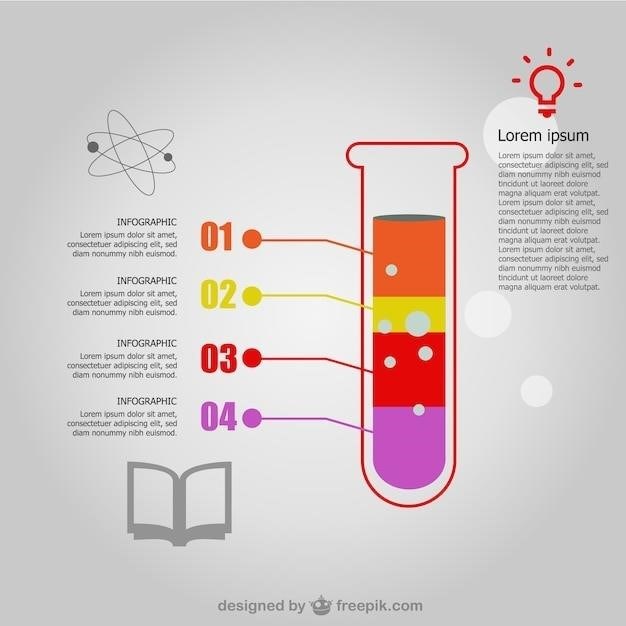Understanding Acid-Base Balance
Maintaining a stable internal pH is crucial for optimal bodily function․ Acid-base balance refers to this delicate equilibrium between acids and bases in the body’s fluids․ Disruptions to this balance can severely impact enzyme activity and overall health․ Understanding this balance is key to diagnosing and treating various medical conditions․
Defining Acids and Bases
Acids are substances that donate hydrogen ions (H+) to a solution, increasing its hydrogen ion concentration․ Conversely, bases are substances that accept hydrogen ions, decreasing the hydrogen ion concentration․ The strength of an acid or base is determined by its tendency to donate or accept protons․ Strong acids completely dissociate in water, releasing all their hydrogen ions, while weak acids only partially dissociate․ Similarly, strong bases readily accept protons, while weak bases have a lower affinity for protons․ The body utilizes both strong and weak acids and bases, with weak acids and bases playing a crucial role in buffering systems, maintaining a relatively stable pH despite fluctuations in acid or base input․ Understanding the difference between strong and weak acids and bases is essential for comprehending the intricacies of acid-base balance and the mechanisms the body uses to maintain homeostasis․
The Importance of pH
pH, a measure of hydrogen ion concentration, is a critical indicator of the body’s acid-base balance․ A pH of 7․0 is neutral; values below 7․0 are acidic, and values above 7․0 are alkaline (basic)․ The body’s internal environment requires a narrow pH range, typically between 7․35 and 7․45, for optimal function․ Even slight deviations outside this range can significantly impact enzyme activity․ Enzymes, crucial for numerous biochemical reactions, have specific pH optima․ Changes in pH can alter their three-dimensional structure, affecting their catalytic efficiency․ Consequently, deviations from the ideal pH can disrupt metabolic processes, potentially leading to cellular dysfunction and organ damage․ Maintaining a stable pH is essential for cellular integrity and overall physiological homeostasis․ Precise regulation of pH is achieved through a complex interplay of buffer systems, respiratory compensation, and renal mechanisms․

Acid-Base Imbalances
Disruptions to the body’s delicate acid-base balance can lead to serious health consequences; These imbalances, categorized as acidosis (excess acid) or alkalosis (excess base), can stem from metabolic or respiratory issues․
Metabolic Acidosis and Alkalosis
Metabolic acidosis arises from a buildup of acids or a loss of bicarbonate, the body’s primary buffer․ Causes include kidney failure (inability to excrete acids), diabetic ketoacidosis (excessive ketone production), and severe diarrhea (loss of bicarbonate-rich intestinal fluids)․ Symptoms can range from nausea and vomiting to lethargy and shortness of breath․ Treatment focuses on addressing the underlying cause and potentially administering bicarbonate to restore pH balance․ In contrast, metabolic alkalosis results from a loss of acid or an excessive gain of bicarbonate․ Common causes include prolonged vomiting (loss of stomach acid) and excessive diuretic use (loss of potassium and hydrogen ions)․ Symptoms can include muscle weakness, tremors, and tetany․ Treatment often involves addressing the underlying condition and administering fluids to correct electrolyte imbalances․ Both conditions necessitate careful monitoring of blood gas levels and electrolyte concentrations to ensure effective management․
Respiratory Acidosis and Alkalosis
Respiratory acidosis develops when the lungs fail to adequately eliminate carbon dioxide, leading to a rise in blood carbon dioxide levels and a subsequent decrease in pH․ This commonly occurs in conditions like chronic obstructive pulmonary disease (COPD), pneumonia, and drug overdoses causing respiratory depression․ Symptoms can include shortness of breath, confusion, and headaches․ Treatment focuses on improving ventilation, often through mechanical ventilation or bronchodilators․ Conversely, respiratory alkalosis is characterized by excessive elimination of carbon dioxide, resulting in a decrease in blood carbon dioxide and an increase in pH․ Hyperventilation, often triggered by anxiety, high altitude, or pulmonary embolism, is a common cause․ Symptoms may include dizziness, lightheadedness, tingling in the extremities, and muscle spasms․ Treatment aims to reduce hyperventilation, which may involve breathing into a paper bag or addressing the underlying cause․ Both respiratory acidosis and alkalosis require careful assessment of respiratory function and blood gas analysis for effective diagnosis and management․
Regulation of Acid-Base Balance
The body employs multiple mechanisms to maintain pH within a narrow range․ These include chemical buffering systems, renal excretion of acids and bases, and respiratory regulation of carbon dioxide levels․ A coordinated effort ensures stable internal pH․
Buffer Systems in the Body
Buffer systems are the body’s first line of defense against pH changes․ They consist of weak acids and their conjugate bases, which can absorb or release H+ ions to minimize pH fluctuations․ The bicarbonate buffer system, involving carbonic acid (H2CO3) and bicarbonate (HCO3-), is the most important in blood plasma․ It’s crucial for neutralizing excess acids or bases․ Proteins also act as buffers, with their amino acid side chains capable of binding or releasing H+ ions․ Phosphate buffers, primarily found in intracellular fluids and kidney tubules, contribute to pH regulation․ These buffer systems rapidly respond to small pH changes, preventing drastic shifts that could harm cells and enzymes․ Their immediate action buys time for the kidneys and lungs to initiate more long-term corrective mechanisms․ The efficiency of these buffer systems is vital for maintaining a stable internal environment․ Understanding their role is fundamental to comprehending acid-base balance and its regulation within the human body․
Renal and Respiratory Compensation
The kidneys and lungs play crucial roles in long-term acid-base balance regulation․ The respiratory system compensates rapidly for pH imbalances by altering carbon dioxide (CO2) levels․ Increased ventilation eliminates CO2, reducing H+ ion concentration (alkalosis compensation)․ Conversely, decreased ventilation retains CO2, increasing H+ ions (acidosis compensation)․ Renal compensation is slower but more precise․ The kidneys adjust bicarbonate (HCO3-) reabsorption and excretion, influencing plasma HCO3- levels․ They also excrete H+ ions directly, either by secreting them into the urine or by combining them with phosphate and ammonia buffers․ This process is vital for eliminating excess acids and maintaining the desired bicarbonate concentration․ The interplay between respiratory and renal mechanisms ensures the body’s pH remains within the narrow physiological range․ Effective compensation requires the coordinated action of both systems, highlighting their interdependent roles in maintaining acid-base homeostasis․

Clinical Significance
Acid-base imbalances significantly impact health, affecting various organ systems․ Prompt diagnosis and treatment are crucial for preventing severe complications and improving patient outcomes․ Accurate interpretation of blood gas analysis is vital for effective management․
Interpreting Blood Gas Analysis
Blood gas analysis is a cornerstone of acid-base assessment, providing crucial information about arterial blood pH, partial pressure of carbon dioxide (PCO2), and bicarbonate (HCO3–) levels․ Interpreting these values requires understanding their interrelationships and how they reflect respiratory and metabolic processes․ A low pH indicates acidosis, while a high pH signifies alkalosis․ PCO2 reflects respiratory function; elevated levels suggest respiratory acidosis, while decreased levels indicate respiratory alkalosis․ HCO3– reflects metabolic function; low levels point towards metabolic acidosis, and high levels suggest metabolic alkalosis․ Analyzing these parameters together helps pinpoint the primary acid-base disturbance and identify compensatory mechanisms․ Anion gap calculation, considering the difference between measured and calculated anions, further aids in differential diagnosis, particularly in metabolic acidosis․ Clinicians use this integrated analysis to guide appropriate management strategies for diverse acid-base disorders․
